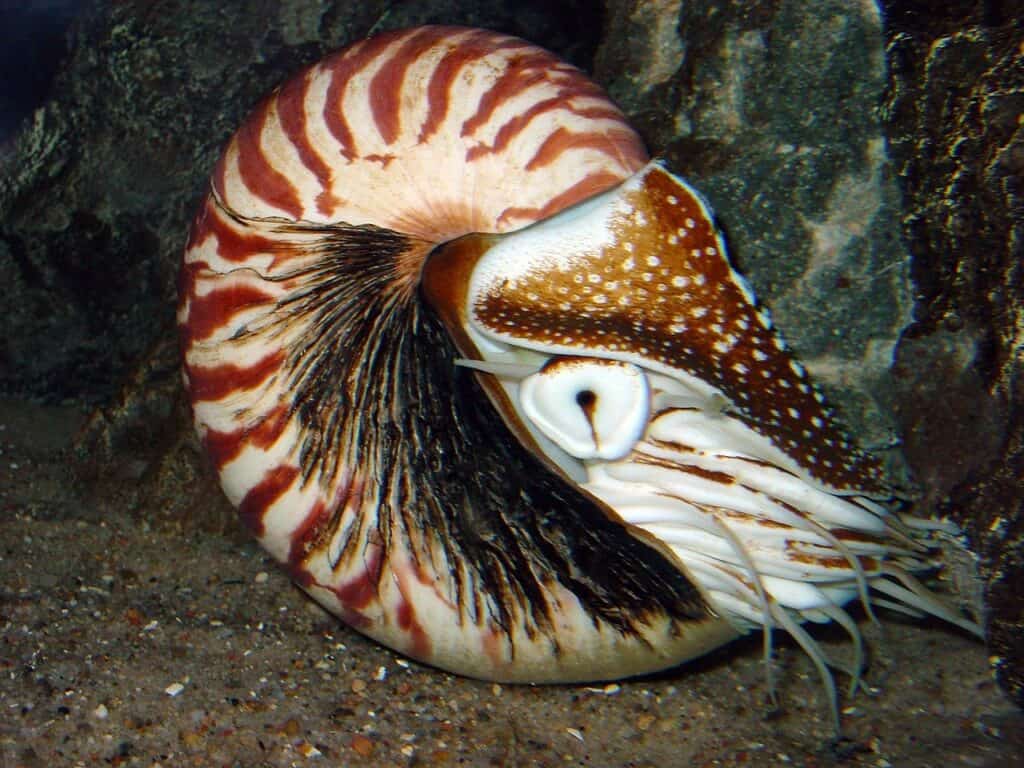Nautilus
Nautilus pompilius
Living fossils that evolved over 500 million years ago
Advertisement
Nautilus Scientific Classification
- Kingdom
- Animalia
- Phylum
- Mollusca
- Class
- Cephalopoda
- Order
- Nautilida
- Family
- Nautilidae
- Genus
- Nautilus
- Scientific Name
- Nautilus pompilius
Read our Complete Guide to Classification of Animals.
Nautilus Conservation Status
Nautilus Facts
- Prey
- Crabs, lobsters, carrion
- Group Behavior
- Solitary
- Fun Fact
- Living fossils that evolved over 500 million years ago
- Biggest Threat
- Overfishing
- Most Distinctive Feature
- Spiral shell
- Gestation Period
- 1 year
- Average Spawn Size
- 10 to 18
Nautilus Physical Characteristics
- Color
- Blue
- White
- Silver
- Lifespan
- 15 to 20 years
- Length
- 4 to 10 inches
- Age of Sexual Maturity
- 10 to 15
- Venomous
- No
- Aggression
- Low
View all of the Nautilus images!
Summary
Named after the Ancient Greek word for sailor, the nautilus is a marine mollusk in the family Nautilidae. A close relative of the octopus, squid, and cuttlefish, the nautilus is a living fossil whose ancestors evolved nearly 500 million years ago. These deep-dwelling scavengers navigate using jet propulsion and a complicated system of chambers that adjust their buoyancy in the water. Highly prized for their decorative spiral shells that resemble pearls on the inside, nautiluses are threatened by overfishing and are some of the rarest marine animals.
5 Nautilus Facts
- The first nautiluses evolved nearly 500 million years ago and remain relatively unchanged to this day.
- Although nautiluses can live for up to 20 years, they typically don’t reach sexual maturity until around 10 or 15 years old.
- Nautiluses have 60 to 90 tentacles covered in a sticky adhesive and tiny hairs that they use to ensnare prey.
- To get around, nautiluses rely on jet propulsion by blowing water through a siphon below the eyes.
- Unlike other cephalopods, nautiluses have poor vision, but they make up for limited eyesight with an excellent sense of smell.
Nautilus Scientific Name
The nautilus is a marine mollusk and a distant relative of cephalopods like squid, cuttlefish, and octopus. All six living species of nautilus belong to the same family, Nautilidae. Four species belong to the type genera, Nautilus, while the other two belong to the genera Allonautilus. The word nautilus derives from the Ancient Greek word nautilos or “sailor.” The best-known nautilus species, the chambered nautilus, also goes by the name the pearly nautilus. It gets its name from both its iridescent appearance and the multiple chambers that it uses to adjust its buoyancy. Its scientific name is Nautilus pompilius, after Numa Pompilius, the second King of Rome.
Nautilus Appearance

The chambered nautilus is the largest living nautilus species. At their largest, chambered nautilus shells can measure nearly 10 inches in diameter.
©J. Baecker / public domain – License
Generally speaking, most nautiluses look more or less similar to one another. All six species by rolled, smooth shells. The shell’s shape is often used as an example of a golden spiral, but in reality, the ratio is only a nearly perfect logarithmic spiral. Nautiluses rely on their shell for protection and can completely pull themselves into the shell and close the opening using specially folded tentacles. The outside of the shell looks matte white, while the inside is iridescent white or blue-gray. Moreover, the shell often exhibits countershading. With countershading, the top of the shell looks darker, while the bottom appears lighter. Inside the shell are several chambers connected in the middle by a duct known as the siphuncle. At birth, a nautilus shell contains around 4 or 5 chambers, while an adult’s shell can contain up to 30 chambers.
Each nautilus possesses 60 to 90 arms of differing lengths, depending on the species. These soft tentacles, or cirri, are made of soft, flexible material and are completely retractable. Each arm is coated in a sticky adhesive substance and tiny hairs known as cilia near the tip of each appendage which they use to smell for food.
The chambered nautilus is the largest living nautilus species. At their largest, chambered nautilus shells can measure nearly 10 inches in diameter. However, some dwarf populations measure as little as 4 inches in diameter when fully grown. Meanwhile, the bellybutton nautilus (Nautilus macromphalus) ranks as the smallest standard species, with an average shell diameter of around 6.5 inches. That said, most nautiluses clock in at around 8 inches in diameter.
Nautilus Behavior
The nautilus relies on jet propulsion to move through the water. It sucks water into a siphon right below its eyes and then expels the water in a stream, pushing itself forward in a straight line away from the direction its siphon faces. To aid itself in traversing the ocean depths, the nautilus adjusts its buoyancy by controlling the amount of water it lets into the chambers located in its shell. Using osmosing, it can add water – causing it to sink – or expel water, which causes it to rise gradually toward the surface.
You rarely find nautiluses near the surface, and they tend to spend most of the time at depths below 500 feet. Nautiluses can withstand great pressures and are capable of living at depths of up to 2,300 feet below sea level. While they can live at lower depths, they normally rise at night to either feed, mate, or lay eggs. At around 2,600 feet, their shells implode, killing them instantly. Unlike many deep-dwelling fish, which promptly die if brought to the surface too quickly, nautiluses do not suffer physical effects caused by a rapid change in pressure.
Compared to other cephalopods, the nautilus displays a relatively low level of intelligence. Its brain is rather simple, and although it does not lack intelligence, its memory skills are extremely limited. While it displays some level of short and long-term memory in response to external conditioning, the nautilus quickly forgets information after just a few hours that more advanced cephalopods can remember for several weeks.
Nautilus Habitat
Today, nautiluses are confined to the Indo-Pacific, with most located near coastal areas of the Indian Ocean or the western Pacific Ocean. They tend to congregate along the slopes of coral reefs and spend most of their time at depths between 500 and 2,300 feet. That said, you can sometimes find them in very shallow water. They undergo vertical migrations, rising at night primarily to feed, mate, and lay eggs, and descending during the day. Nautiluses avoid warmer water, preferring temperatures below 75 degrees Fahrenheit.
Nautilus Diet
As opportunistic carnivores, nautiluses will eat almost anything they can catch. Their diet consists mainly of crustaceans and shellfish such as crabs and lobsters. Moreover, they are willing scavengers and will not hesitate to eat carrion. They use their long arms to ensnare prey and navigate food toward their beaks. Given their poor eyesight, they must rely on other senses to help them find food. For example, the tiny hairs at the end of their arms are likely used to help them “smell” their surroundings and detect detritus and anything else edible that smells.
Nautilus Predators and Threats
The nautilus’s main predators include other cephalopods, such as the octopus, as well as sharks, groupers, sea turtles, and triggerfish. During the day, nautiluses dive deep below the surface to avoid predators. The countershading on their shells aids them in avoiding detection. For example, the top of the shell appears darker, while the bottom appears lighter. This makes them harder to detect from above, as they blend into the dark water below, and also difficult to spot from below, as they blend into the lighter water above. When threatened, nautiluses will retract into their shells and cover the opening with a leathery hood created by a specialized pair of folded arms.
Aside from natural predators, the main threat to nautiluses comes from human activity. Nautiluses are collected both for food and for use as souvenirs and collectibles. People prize their shells for their shape and color, as the inside serves as a suitable pearl substitute. Given their slow sexual maturity, low birth rates, and long gestation periods, nautiluses are extremely susceptible to over-exploitation.
Nautilus Reproduction and Life Cycle
Nautiluses don’t have specific mating seasons. They can breed any time of the year and typically do so nearer to the surface. Strangely, males vastly outnumber females, who only comprise around 20 to 30 percent of the total nautilus population. As a result, a single female often must contend with the affections of multiple male suitors. Nautiluses mate face-to-face, during which time the male will transfer his sperm to the female’s mantle using four specialized tentacles that form an organ known as a spadix. Mating sessions can last for hours, and males sometimes leave bite marks on the females from where they latched under during the coupling.
Like other cephalopods, nautiluses reproduce by laying eggs. However, unlike most cephalopods, which produce objectively tiny eggs, nautilus eggs are relatively large, measuring approximately 1 to 1.5 inches long. Moreover, they lay relatively few eggs, with most females laying between 10 and 18 eggs per year. Females attach their eggs to rocks in warm water either singly or in small groups. The eggs gestate for around 12 months before hatching.
Nautiluses can live up to 20 years in the wild, significantly longer than other cephalopods. However, while they can live for a comparatively long time, they mature very slowly. On average, nautiluses reach sexual maturity between 10 and 15 years old.
Nautilus Population
Over the past few decades, nautilus populations have declined considerably due to overfishing. Given their low birth rate, delayed sexual maturity, and long gestation period, nautilus populations are extremely vulnerable to even mild reductions in numbers. Each year, fewer and fewer nautiluses remain, and sightings occur more infrequently. Some species are so rare that years can go by without divers or fishers encountering them in the wild. While regulations exist to protect nautiluses, they remain threatened and on the decline.
Nautilus Locations
You can find Nautiluses primarily in the western Pacific Ocean and coastal regions of the Indian Ocean. They prefer warm temperate waters and are most heavily distributed around southeast Asia and Australia. Nautiluses are particularly dense in the waters around the Great Barrier Reef, the Philippines, southern Japan, and Indonesia.
Nautilus Conservation Status
All nautilus species are threatened due to over-exploitation. Its value mainly comes from its shell, which remains prized as an ornament for decorations and souvenirs. As of 2016, nautiluses are classified under CITES Appendix II, a multilateral treaty restricting international trade in nautilus. Additionally, the Endangered Species Act in the United States recognizes the nautilus as a threatened species.
View all 65 animals that start with NNautilus FAQs (Frequently Asked Questions)
Are nautiluses carnivores, herbivores, or omnivores?
Nautiluses are opportunistic predators and scavengers. These carnivores subsist primarily on crabs, lobsters, and carrion.
What is a nautilus?
The nautilus is a mollusk in the cephalopod class that includes cuttlefish, octopus, and squid. It uses jet propulsion to navigate and features an intricate spiral shell.
Is a nautilus rare?
Nautiluses are in decline, thanks to overfishing compounded by their low birthrate, delayed sexual maturity, and long gestation period. One species, the crusty nautilus (Allonautilus scrobiculatus), went unreported for nearly 30 years and was thought extinct until a sighting in 2015, making it one of the rarest marine animals on Earth.
Does a nautilus have eyes?
The nautilus does possess eyes, but its vision is rather poor. Its eyes lack a lens or cornea and function more as a pinhole rather than a camera.
Thank you for reading! Have some feedback for us? Contact the AZ Animals editorial team.

















